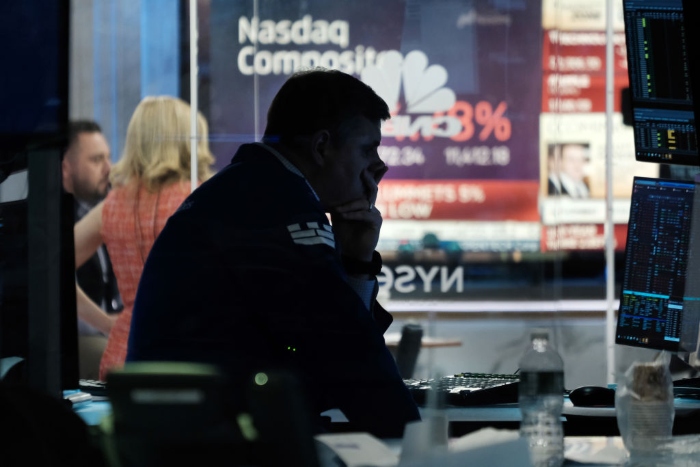Tomorrow’s conversation, tonight. Know where the news is going next.
Get the POLITICO Nightly newsletter
By signing up you agree to receive email newsletters or updates from POLITICO and you agree to our privacy policy and terms of service. You can unsubscribe at any time and you can contact us here. This sign-up form is protected by reCAPTCHA and the Google Privacy Policy and Terms of Service apply.
By BEN WHITE
05/27/2022 05:00 PM EDT
Presented by
Traders work on the floor of the New York Stock Exchange. | Spencer Platt/Getty Images
WALL STREET’S WEIRD PANDEMIC — A bit of a strange thing happened when Covid-19 rocked the U.S. starting in early 2020. Well, more than one strange thing, but I’m thinking of this one: Stocks went on a crazy ride higher. Much of the economy shut down and we all cowered in our homes — hoarding cash and learning Zoom. But Wall Street soared.
Sure, stocks took an initial dive in late February and early March of 2020, the scariest of Covid times. But they quickly found a bottom in mid-March and began a rally that pushed all three major indices (the Dow, Nasdaq and S&P 500) to record highs.
Then, something like the reverse happened: With Covid waning, unemployment down to under 4 percent and consumers dumping cash back into the economy, stocks started to tank. And tank hard.
Despite decent rallies the last couple of days, the S&P 500 remains down double digits for the year. Nasdaq, home to the big tech names that raced ahead during Covid, took the worst of it and is now off around 23 percent for the year.
So what the heck happened? There are several reasons for why it looks like investors blew off the virus and are now panicking during the recovery.
First off, as you’ve likely heard, the stock market is not the economy. It’s basically a mechanism reflecting investor beliefs about future corporate profits, sometimes many years in the future. During the pandemic, investors determined the damage would not be terrible and longer term prospects looked good.
“Markets don’t move on the absolutes of ‘good’ or ‘bad.’ They move based on ‘better’ or ‘worse,’” Richard Bernstein, founder of Richard Bernstein Advisors, emailed Nightly. “The economy tanked in the first half of 2020 and was ‘bad’ in an absolute sense, but quickly began to get ‘better.’ Today the economy is ‘good’ but the fears are it will get meaningfully ‘worse.’”
Bernstein said he thinks those fears are way overblown “because there is little evidence a recession is looming.”
Another huge reason for the seeming disconnect between Wall Street and the virus: Massive government spending and support from the Federal Reserve. Between the Trump and Biden administrations, the federal government pumped trillions of dollars into the economy through direct checks, generous jobless benefits, expanded tax credits and the like.
And the Fed, which had been gently trying to nudge interest rates higher before the pandemic, immediately reversed course and kept rates at effectively zero. The central bank also kept gobbling up trillions of dollars in assets in the form of corporate and mortgage-backed bonds and other securities. This essentially amounted to printing money.
Wall Street loved all of it.
Stock market investors want low interest rates so that stocks remain more attractive investments with higher returns than bonds. And they adore the government pumping money directly into consumer wallets to drive spending that fuels two-thirds of the U.S. economy.
But all of this – coupled with war and screwed-up supply chains – can create significant price inflation. And that’s just what it’s done.
The latest numbers: Inflation stayed near 40-year highs in April at 8.3 percent. That’s down, but just slightly, from March’s 8.5 percent.
Wall Street hates inflation, more than it hated the virus. It cuts into the value of future profits – which is why tech has had it the worst this year – and pushed the Fed back into rate hiking mode.
Rate hikes “makes things like make-believe assets like crypto very unattractive — and stocks somewhat less attractive at lofty valuations,” Brett Ryan, senior U.S. economist at Deutsche Bank emailed.
Welcome to POLITICO Nightly. Programming Note: We’ll be off this Monday for Memorial Day. We will be back in your inboxes on Tuesday, May 31. Reach out with news, tips and ideas at [email protected]. Or contact tonight’s author at [email protected], or on Twitter at @morningmoneyben.
A message from Bank of America:
Perspectives from small businesses: See how U.S. small businesses are demonstrating resilience and adaptability in the face of operational challenges in Bank of America’s 2022 Small Business Owner Report.
— Texas official: Police made ‘wrong decision’ to wait on breaching Uvalde classroom: A Texas official said today that local police made the “wrong decision” by waiting nearly an hour to breach the elementary school classroom where a gunman shot and killed 19 children and two teachers. Nearly 20 officers stood outside the classroom during the Tuesday attack at Robb Elementary School in Uvalde, Texas. The on-scene commander believed at the time that 18-year-old gunman Salvador Ramos had barricaded himself and that the children were no longer at risk, Texas Department of Public Safety Director Steven McCraw said at a news conference.
— More than 100 House Dems call for push beyond ‘red flag’ laws: A group of 134 Democrats from across the party are urging their leadership to take up more gun safety legislation, even as momentum in the Senate focuses mostly on a potential “red flag” bill, which the full House will take up next week. Within the caucus, there’s been some preliminary discussion about how much floor focus to give gun bills — with no way to overpower the Senate filibuster and time running short before the midterms. But the group argues in the letter: “We believe this is something worth fighting for, no matter the political consequences.”
— Dr. Oz jumps the gun, declares himself ‘presumptive’ GOP Senate nominee: As state officials start the official recount in Pennsylvania’s too-close-to-call Senate GOP race, celebrity doctor Mehmet Oz declared in a video today that he has “earned the presumptive Republican nomination.” Oz is leading former hedge fund CEO David McCormick by 923 votes, or .07 percent, heading into the recount.
Republican U.S. Senate candidate Mehmet Oz greets supporters after the primary race resulted in an automatic re-count due to close results in Newtown, Pa. | Stephanie Keith/Getty Images
— Judge dismisses Trump’s lawsuit seeking to stop New York civil probe: A federal judge today tossed out former President Donald Trump’s lawsuit seeking to stop the New York attorney general’s probe of his business dealings. Trump alleged in the suit that New York Attorney General Tish James violated his constitutional rights by launching an investigation into the Trump Organization “in bad faith and without a legally sufficient basis.”
— Centrist Schrader ousted in Oregon primary: Rep. Kurt Schrader, a seven-term centrist Democrat from Oregon, has lost his primary to a progressive challenger, handing a massive win to the party’s left flank. Jamie McLeod-Skinner, an attorney and business owner endorsed by Sen. Elizabeth Warren (D-Mass.), benefited from the decennial redistricting process, which left Schrader running in a district that was largely new territory to him.
KYIV’S WISH LIST UPDATE — The Biden administration is inclined toward sending Ukraine advanced, long-range rocket systems that leaders in Kyiv have requested for months, but no final decision has been made, two U.S. officials tell POLITICO.
Neither President Joe Biden nor Defense Secretary Lloyd Austin has approved the next batch of aid for Ukraine, the officials said. But the U.S.-made Multiple Launch Rocket System and the High Mobility Artillery Rocket System, some versions of which can launch rockets farther than any weapons Ukraine currently possesses, could be part of the package, Paul McLeary and Lara Seligman write.
Certain advanced munitions fired by the MLRS can reach up to 190 miles, but “no long-range strike weapons are being considered” as part of the package, one administration official cautioned. Instead, the U.S. is weighing supplying rockets that can travel roughly between 20 to 45 miles, further than the shells fired by the M777 howitzers sent to Ukraine in May, which can reach about 15 miles.
The White House has grappled for months over whether to send Ukraine weapons that would allow greater offensive capabilities. The Biden administration and the West more generally have to date declined to supply the longer-range munitions Kyiv desperately wants, including air power. President Volodymyr Zelenskyy has railed against the U.S. decision not to backfill Poland with F-16s when Ukraine asked for Polish MiG-29 fighter planes early in the war. But despite sending billions of dollars in military hardware to the front, Washington has worried about provoking Vladimir Putin into committing further atrocities or escalating to chemical or nuclear weapons if Ukraine launches larger-scale attacks inside Russia.
A message from Bank of America:

2,147,736
The number of air travelers through TSA checkpoints on Wednesday, May 25, 2022; according to the agency, the number of people who flew on the Wednesday before Memorial Day in 2021 was 1,854,534.
Tom Cruise attends the Royal Film Performance and UK Premiere of “Top Gun: Maverick” at Leicester Square in London. | Eamonn M. McCormack/Getty Images for Paramount Pictures
HEADING INTO HOT SUMMER NIGHTS — Plenty of people across the country will be headed to movie theaters for a dose of nostalgia and military machismo for “Top Gun: Maverick” and its opening weekend. And, if you’re a POLITICO Pro subscriber passionate about all things aviation, our Lee Hudson had you covered this morning in Morning Defense with a rundown of the things to look out for in the film. Here are a couple from her list to share. (Also, watch out for spoilers below!)
— Besides Tom Cruise, the other star of the movie is the Boeing F/A-18E/F Super Hornet. You may be wondering why they didn’t fly the newer F-35 instead, but we’re hearing it’s because they needed a two-seater to make the movie work (actors flew in the backseat).
Movie creators wanted the dogfighting scenes to be realistic, including real G forces swelling actors’ faces.
— But F-35 maker Lockheed Martin doesn’t come away empty-handed. In the first act, Capt. Pete “Maverick” Mitchell flies (borrows? steals?) a stealth aircraft at Lockheed’s super-secret SkunkWorks desert facility. Sure, he crashes it, but c’mon, he goes Mach 10 first.
— The hypersonic stealth fighter Maverick flew was called “Darkstar,” which may be inspired by artist renderings for the SR-72, the follow-on to the SR-71 Blackbird.
As The Drive reported, the film crew worked with SkunkWorks to dream up the aircraft. And for good measure, it’s powered by a scramjet engine and even uses Mach as a unit of measurement.
Oh, and China noticed, too.
A message from Bank of America:
Bank of America’s 2022 Small Business Owner Report launched earlier this month and found that inflation and supply chain issues are impacting the majority of U.S. small business owners, causing operational challenges including price increases and sourcing new suppliers.
Despite growing concerns around the direction of the economy, entrepreneurs are resilient and betting on their businesses, as 64% anticipate their revenue will increase in the year ahead.
“Small business owners are betting on their businesses and seeking opportunities for expansion, despite concerns about the economy,” said Sharon Miller, President of Small Business and Head of Specialty Banking and Lending at Bank of America. “While facing a highly challenging environment, entrepreneurs are demonstrating resilience and adaptability as they focus on the operational and strategic decisions that directly impact their customers and employees.”
Get the insights.
Did someone forward this email to you? Sign up here","link":{"target":"NEW","attributes":[],"url":"https://www.politico.com/newsletters/politico-nightly-coronavirus-special-edition","_id":"00000181-0a9f-d956-abb1-1fdffb330000","_type":"33ac701a-72c1-316a-a3a5-13918cf384df"},"_id":"00000181-0a9f-d956-abb1-1fdffb330001","_type":"02ec1f82-5e56-3b8c-af6e-6fc7c8772266"}”>Sign up here.
© 2022 POLITICO LLC
